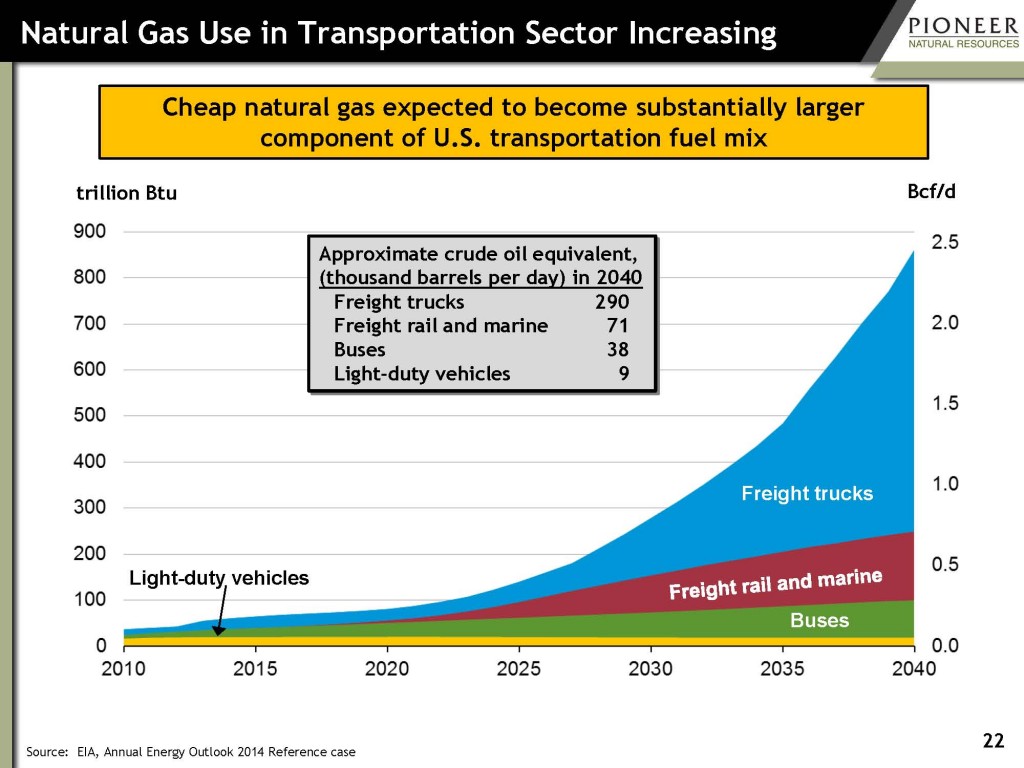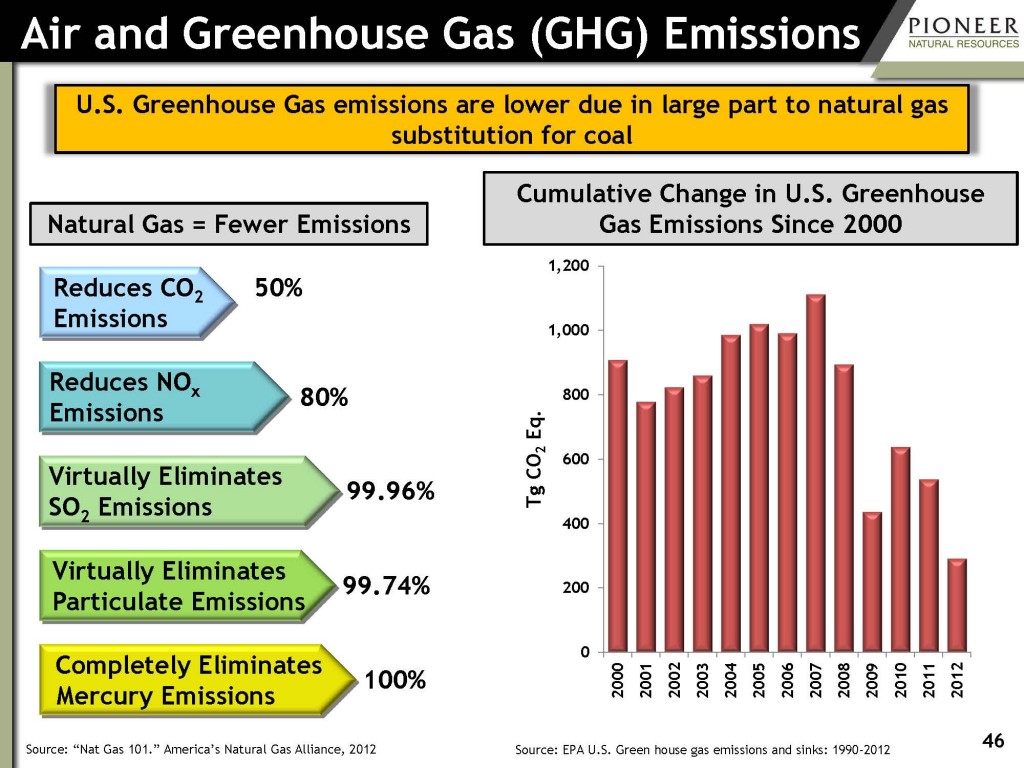A few years ago, electric cars made a splash in the transportation landscape by presenting an alternative to traditional diesel or gasoline powered vehicles. Sales have increased to 114,530 units sold in 2013 from 17,724 units sold in 2011 (a 546% increase). Customers now have the option of choosing from 18 different models compared to just two at the beginning of 2011.
Electric cars have changed the landscape of America’s roadways, but the monster 18-wheelers rolling down the interstate may have found another transportation fuel: natural gas. Pioneer Natural Resources (ticker: PXD) highlighted the United States shale revolution while presenting in Singapore on September 29, 2014. The presentation was titled, “A Game Changer for the Country.”
Natural Gas A Fit for Heavy Duty Vehicles
 Natural gas will not rival the use of gasoline or diesel in the near future, but its market is just getting off the starting blocks. As seen in the chart on the right, the Energy Information Administration expects natural gas use for the transportation sector to increase to 863 trillion Btu in 2040 from 43 trillion Btu in 2012 (compound annual growth rate of 11%). Total gas use is roughly equal to one-half of all gas currently produced from the Niobrara formation.
Natural gas will not rival the use of gasoline or diesel in the near future, but its market is just getting off the starting blocks. As seen in the chart on the right, the Energy Information Administration expects natural gas use for the transportation sector to increase to 863 trillion Btu in 2040 from 43 trillion Btu in 2012 (compound annual growth rate of 11%). Total gas use is roughly equal to one-half of all gas currently produced from the Niobrara formation.
Medium and heavy duty vehicles, defined as tractor trailers and large trucks or vans, will make the biggest gains in natural gas use. Their share is projected to jump to 613 trillion Btu in 2040 from 11 trillion Btu in 2012 (compound annual growth rate of 15.4%). Navigant Research estimates one in seven medium or heavy duty vehicles will be powered by alternative fuels in 2035. The EIA contributes natural gas gains to “A relatively high-mileage application in which the fuel cost savings of LNG offset the significant incremental capital cost of LNG vehicles.”
Bob Lukefahr of The Wall Street Journal compared the differences of natural gas and electric vehicles more sharply in his piece on September 26, 2014. “Do some simple math and it quickly becomes apparent that natural-gas vehicles (NGVs) will displace 10-12 times more gasoline and diesel than the 250,000 electric cars currently on the road,” he says. “When complete, [a] small fleet of 24 natural-gas tow trucks will displace more gasoline than around 700 Chevy Volts. And here is a nice side benefit: Those Volts would cost federal taxpayers a whopping $5.3 million in subsidies while [the] F650 Fords cost them nothing.”
Transportation companies with truck fleets are beginning to switch to natural gas, including Paper Transport and the United Parcel Service. Kenworth began pushing for natural gas-powered vehicles as early as 2011, when it hosted a NatGas Summit.
“The cost advantage of gas motor fuel [equivalent to about $1.50 to $2 per diesel gallon] alone makes the case for natural gas,” said Andy Douglas, national sales manager for Kenworth. “Fleets really don’t need government subsidies to make it financially attractive.”
Will it Meet its Forecast?
 Recent articles from The Wall Street Journal and The Houston Chronicle say natural gas interest among heavy duty vehicles is increasing (nearly 10,500 this year, up 20% from last year). However, the increase is not at the rate previously expected. Natural gas users have said paybacks are on pace to be recouped in four years and that the limited infrastructure can pose convenience problems. Some large corporations have natural gas fueling stations on site, but the costs can range up to $1 million per station.
Recent articles from The Wall Street Journal and The Houston Chronicle say natural gas interest among heavy duty vehicles is increasing (nearly 10,500 this year, up 20% from last year). However, the increase is not at the rate previously expected. Natural gas users have said paybacks are on pace to be recouped in four years and that the limited infrastructure can pose convenience problems. Some large corporations have natural gas fueling stations on site, but the costs can range up to $1 million per station.
“There’s not a huge savings today with natural gas,” said Jeff Shefchik, president of Paper Transport, in an interview with The Wall Street Journal. “But we’re content to invest in it because it’s going to grow over time.”
Douglas does not believe the slower-than-expected market is a true indicator of natural gas’ prevalence. “The question is not if, but when,” he said. “Eighty years ago, diesel was the alternative fuel. It took 25 years for it to become common.”
[sam_ad id=”32″ codes=”true”]
Important disclosures: The information provided herein is believed to be reliable; however, EnerCom, Inc. makes no representation or warranty as to its completeness or accuracy. EnerCom’s conclusions are based upon information gathered from sources deemed to be reliable. This note is not intended as an offer or solicitation for the purchase or sale of any security or financial instrument of any company mentioned in this note. This note was prepared for general circulation and does not provide investment recommendations specific to individual investors. All readers of the note must make their own investment decisions based upon their specific investment objectives and financial situation utilizing their own financial advisors as they deem necessary. Investors should consider a company’s entire financial and operational structure in making any investment decisions. Past performance of any company discussed in this note should not be taken as an indication or guarantee of future results. EnerCom is a multi-disciplined management consulting services firm that regularly intends to seek business, or currently may be undertaking business, with companies covered on Oil & Gas 360®, and thereby seeks to receive compensation from these companies for its services. In addition, EnerCom, or its principals or employees, may have an economic interest in any of these companies. As a result, readers of EnerCom’s Oil & Gas 360® should be aware that the firm may have a conflict of interest that could affect the objectivity of this note. The company or companies covered in this note did not review the note prior to publication. EnerCom, or its principals or employees, may have an economic interest in any of the companies covered in this report or on Oil & Gas 360®. As a result, readers of EnerCom’s reports or Oil & Gas 360® should be aware that the firm may have a conflict of interest that could affect the objectivity of this report.

